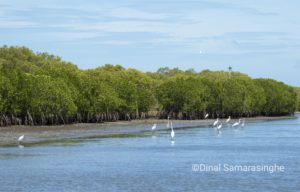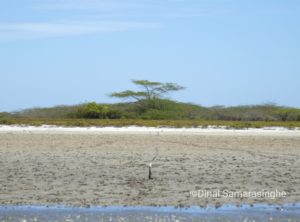By Piyumani Ranasinghe
Whilst the debacle on environment calamities in Sri Lanka attest to a list of administrative failures in protecting the environment, the story of possibly the largest mangrove forest in Sri Lanka is now in line. Situated in the Northwestern coast of the island, Wedithalathive adjoins the Vankalai Sanctuary in Mannar District. The reserve encloses an ecosystem of mangroves, tidal or mud flats, salt marshes, sea grass beds as well as coral reefs which provides habitat to many plants and animal species, especially a feeding ground and roosting of thousands of migratory birds. The mangroves, sea grass beds as well as the coral reefs act as natural barriers in protecting our coasts against tsunami, storms, tidal waves as well as coastal flooding. They are also nurseries and grow-out areas for fish and shellfish. Most importantly, mangroves act as the barrier for sea water intrusion to land enabling paddy farming just off the coast. This vibrant ecosystem has been supporting the livelihoods of fishermen in the area for decades and is a hub for blue swimmer crab, which brings foreign exchange into the country as it is a sought-after sea food.
Despite this rich biodiversity, Environmental Foundation Guarantee Limited (EFL) has highlighted the ongoing tug-of-war between the Ministry of Environment and Wildlife Resources and the Ministry of Fisheries and Aquatic Resources to degazette the Wedithalathive Nature Reserve – where the Wildlife Ministry is now pushed to be the enemy of its very own mandate. Whilst this may not sound surprising due to ‘business as usual’ in the small island nation, the question at hand is whether Sri Lanka can afford to lose yet another pristine ecosystem due to administrative laxity and the blatant disregard of the rule of law.
Story of Wediththalathive: Becoming a Nature Reserve
Prior to 2009, Wedithalathive was significant not only because of its rich biodiversity, but also due its strategic location as the naval base of the Liberation of Tamil Tigers Eelam (LTTE). The immaculate mangrove forest and its thick dispersion is strategically located between Palk bay and Gulf of Mannar, which is an important naval hub to the Sri Lankan government especially in ensuring the security of our coasts today. In 2014, an Integrated Strategic Environment Assessment (ISEA) was conducted in the Northern Province of Sri Lanka, which at that point of time was almost an alien region to the rest of the island due to the devastation caused by the thirty-year long war. Over 25 government agencies came together, to understand the natural resource base and environmental consequences, after the conflict to provide strategic information in facilitating development as well as conservation in the Northern Province. One of the key recommendations made in this detailed report outlined the significance of the pristine natural environment of Wedithalathive and recommended the Department of Wildlife Conservation (DWC) to gazette the reserve as a high priority conservation site under the Flora and Fauna Protection Ordinance (FFPO). The ISEA specifically directed the government agencies to consider the high priority wildlife areas and forest areas as a single conservation network, which signified the vitality of avoiding any forms of fragmentation of the ecosystem. Accordingly 29,180 hectares of land and sea was declared as the Wedithalathive nature reserve on March 1, 2016 under an extraordinary gazette No. 1956/13 by the DWC.
Crisis Timeline: Attempts to Degazette
In 2017 an year after the declaration, the National Aquaculture Development Authority (NAQDA) requested the Government to degazette the Nature Reserve in order to carry out an aquaculture project in the area. In light of the ISEA, this was a request seeking permission to fragment or perforate the ecosystem, an action completely aversive to the recommendations made in the study. The project by NAQDA proposed to grow fish and shellfish including an exotic prawn species, Litopenaeus vannamei (the king prawn) which originates from the Eastern Pacific Ocean. There are several legal concerns in the entire proposed project, especially in terms of introducing an alien species of prawn against the clear policy set out by the Ministry of Environment on introducing and screening of invasive alien species. Since the effects of such species have not been assessed in Sri Lanka, experts have indicated a myriad of ecological and health implications that can result from the short-sighted project. NAQDA has already brought in Litopenaeus vannamei into its model farm completely ignoring the directive of the Ministry of Environment. Besides, in reality aquaculture projects in Sri Lanka are a failed enterprise as seen in the abandoned lands from Mundel to Puttalam, just south of Wedithalathive. Most projects promised high foreign exchange revenue at the cost of mangroves and are now abandoned lands causing much distress to the entire mangrove ecosystem of the island.
Against this backdrop, a Cabinet Paper was co-sponsored by Mr. Gamini Jayawickrema Perera, who was then the Minister of Sustainable Development and Wildlife and Mr. Mahinda Amaraweera, the Minister of Fisheries and Aquatic Resources Development, to degazette the reserve and reduce its size. Whilst the Minister of Wildlife has the ability to alter the limits or cease an existing Nature Reserve under the FFPO, his discretion is subjected to two limitations. Firstly, prior approval of the parliament should be obtained under Section 2(4). Secondly, a study should be conducted to investigate the ecological consequences of the proposed change under Section 2(5). The type of study mandated under this section is more comprehensive than a regular EIA because it seeks to alter or cease an existing nature reserve.
Accordingly, the ToR for the study was prepared by DWC and Central Environmental Authority (CEA). As the project proponent, the Ministry of Fisheries subsequently handed over the task of conducting the study to National Aquatic Resources Research and Development Agency (NARA). The report, despite its poor informational quality and absence of vital data as requested by the ToR of the study, highlighted the significant biodiversity of Wedithalathive which could be lost forever if the reserve was to be degazetted.
In 2019, DWC appointed a Technical Expert Committee (TEC) to study this report. Upon further review, the TEC submitted written observations against the request to degazette due to the obvious ecological impact resulting from the fragmentation of the ecosystem.
Despite following the due procedure outlined in FFPO and informing the Ministry of Fisheries of the decision taken by the TEC, the pressure to degazette the Wedithalathive Nature Reserve continues till date. Several meetings have been called even after delivering the TEC’s decision, to exert undue political pressure on DWC and Ministry of Wildlife by NAQDA and the Ministry of Fisheries and Aquatic Resources Development. This is evidence of the lack of respect for due process, the rule of law as well as the national policy on sustainable development by administrators of NAQDA, ultimately boiling it down to environmental politics in a fool’s paradise.
Environmental Rule of Law in Sri Lanka
Whilst Wedithalathive remains stuck in this administrative and political quagmire, it should be noted that the Sri Lankan government adopted the Commonwealth Blue Charter in 2018 where it pledged to champion the collaboration on mangrove restoration. Further, in March 2019 Sri Lanka submitted a resolution along with Indonesia to the United Nations Environmental Assembly, calling world leaders to take action on the global health of mangroves. In January 2020, a National Policy was formed to conserve and sustainably utilize Mangrove Ecosystems in Sri Lanka. The aim of the policy was to integrate all government agencies into the task of protecting the patches of mangroves dispersed around the island. In light of all these developments, the continued attempts to degazette the nature reserve questions the efficacy of the environmental rule of law in Sri Lanka. Political interests are seemingly defying the rules of the game evincing the abysmal administration and the lack of regard for rule of law in the country.
Rule of law, thus becomes one of the biggest hurdles in environmental conservation. According to the seven guiding principles of environmental rule of law stipulated by the United Nations Environmental Programme (UNEP), accountability and integrity of institutions and decision-makers is of essence in overcoming this challenge. Hence, the blatant disregard of existing laws, policies and international commitments is concerning not only because of the resulting ecological impact, such as in the case of Wedithalathive, but also because allowing to degazette the reserve sets out a dangerous precedent where political interests can override the rule of law. Crucially, this also signals at the potential list of unenlightened political projects awaiting approval to fragment the rich ecosystems of Sri Lanka in the future. (The views expressed are independent and the author can be reached at piyumaniranasinghe@gmail.com)




Leave Comments